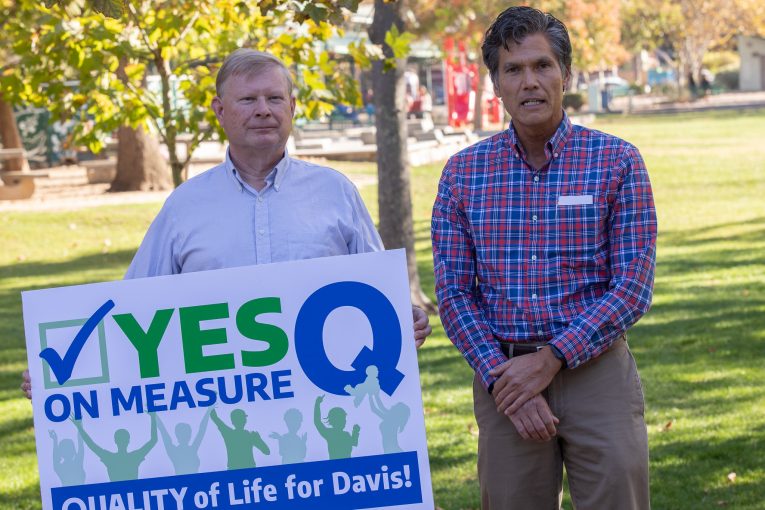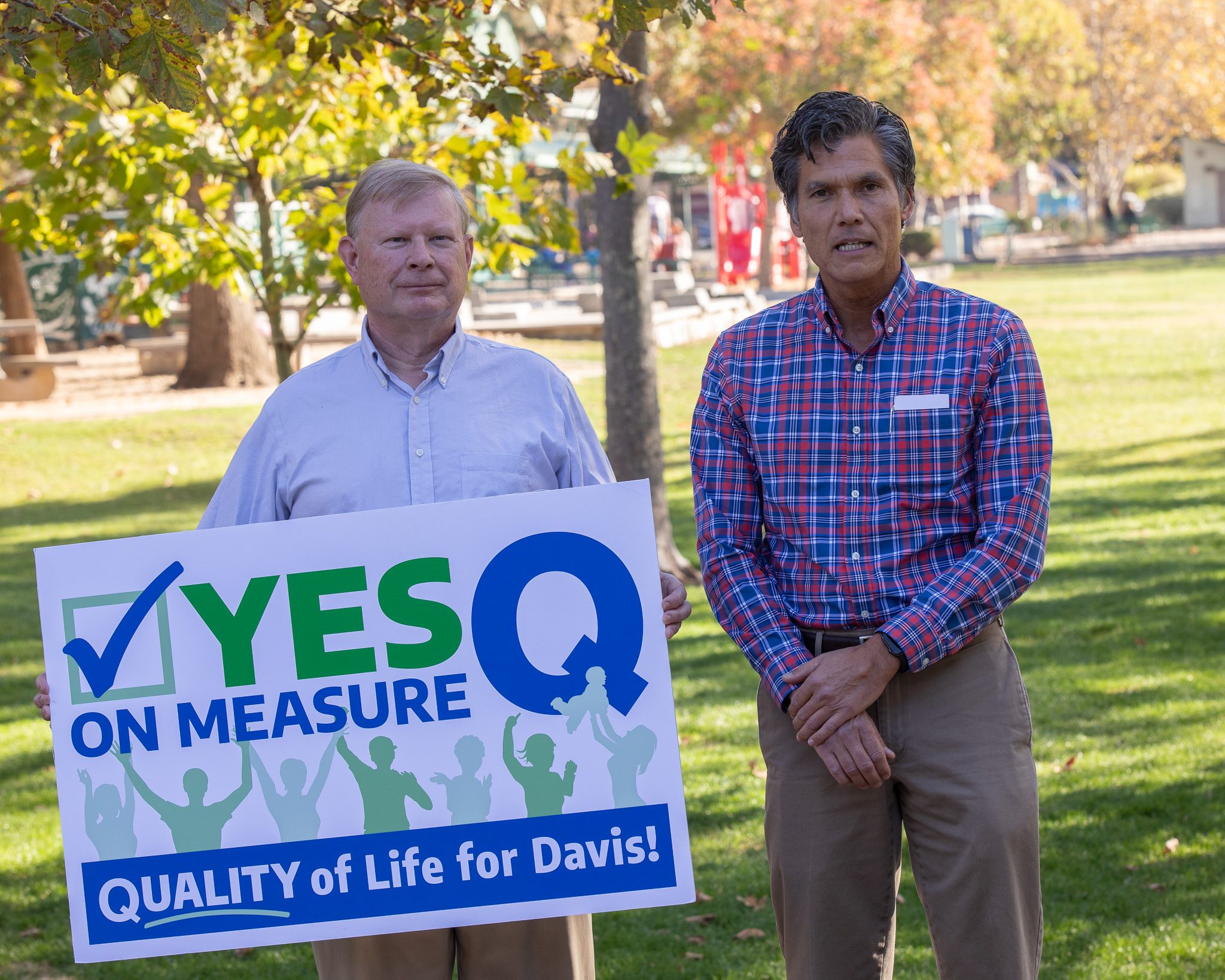

All indications are that Measure Q will cruise to victory on March 3. There is not even token opposition to the measure that would permanently renew the one percent sales tax that generates about $8.6 million per year for the city.
If you recall when the city polled on the sales tax, it started out at around 77 percent support and reasonably varies between 71 and 77 percent. This is a general tax, which means it only needs a majority of votes.
This weekend the measure gained the endorsement of the Davis Enterprise.
Writes the Enterprise: “THE MEASURE would permanently lock in the sales-tax rate that voters approved in 2014, leaving it at 8.25 percent. This is a half-point lower than Sacramento, the same as West Sac and a quarter-point higher than Woodland. That $8.6 million the tax generates is about 16 percent of the general fund, which supports police, fire, parks, recreation and roads.”
The editorial notes: “Out of that 8.25 percent, the city’s 1-percent portion stays entirely in Davis.”
The editorial adds: “Renewing a tax isn’t an increase. By maintaining the sales tax at its current level, we can help maintain these unique Davis features at the level we’ve come to expect.  Removing this funding would necessitate across-the-board cuts on virtually everything the city does.”
Removing this funding would necessitate across-the-board cuts on virtually everything the city does.”
But in a way that is precisely the problem.
Passing Measure Q accomplishes one major goal – it locks in the one percent sales tax in perpetuity. That’s not a bad thing from the city’s perspective. No longer will they have to plan their long-term budgeting by looking at the sunset date for the sales tax.
Moreover, while a sales tax is considered regressive in terms of its impact on residents, one nice thing is that because it is a percentage of sales rather than a flat rate, it comes with its own escalator.
But that is the only real objective that this measure fulfills.
At the same time, just two weeks ago the council was addressing the issue of roads. The council appointed a subcommittee of Mayor Pro Tem Gloria Partida and Councilmember Dan Carson “to work with staff and the Finance and Budget Commission to identify opportunities and mechanisms to increase annual funding allocations for roadway maintenance and report back to the City Council.”
At that time, staff wrote: “In order to reach the target PCI values set by City Council in 2013 (68 for arterials, 65 for collectors, 60 for residential/local streets and 68 for bike/multi-use paths), the analyses indicates that the City needs to spend approximately $7.9 million per year on streets and $3.9 million per year on bike paths over the next 10 years.”
During the meeting two weeks ago, Dan Carson stated, “Some of the work that we need to do to address these rather daunting numbers is just the things we’ve talked about, dealing with the city’s overall fiscal shortfalls, which we last calculated at $8 million but know surely now is more than that.”
Here’s the reality – with the addition of about $1.2 million from SB 1, the city now has about $5 million available annually for road maintenance.
As staff writes: “The approximately $4 million in local fund investment that Council directed in 2013 plus the approximately $1.2 million provided annually in SB 1 funds is making a meaningful difference in the City’s ability to more pro-actively address pavement management.”
But we need twice that.
Had the city council taken the chance on the sales tax measure being a lot closer, they would have increased the sales tax from 1 percent to 1.5 percent. That would have put the city’s sales tax at 8.75 percent – the exact same as Sacramento.
That added half percent would have generated about $4.3 million. That would not have gotten the city to the $10 million mark for roads, but it would have been close.
Given the polling of the previous measure at over 70 percent, given the lack of any opposition for the renewal, why not attempt to get the revenue that you need?
Instead, Davis, with demonstrably the worst roads in the region, is continuing down the path of status quo.
There is no doubt that we will pass Measure Q. There is some utility to locking that rate in, in perpetuity. But in two years, we are going to be in the same position that we were in today and the same position that we were in previously in 2018 when the voters only supported the parcel tax with 57 percent of the vote.
Sometimes in order to alleviate the fiscal problems you need to take some chances. This would have been a risk, but given the high support for the measure, not much of one.
What does a half cent mean? It’s half a cent on each dollar you spend. That’s 50 extra cents each time you spend $100, $5 every time you spend $1000 and $50 every time you spend $10,000.
For that we could have a measure of fiscal resiliency that we just lack now. Seems like a small price to pay and a small risk to take, and yet our leaders left potential money on the table.
—David M. Greenwald reporting


The die has been cast… ballots are being printed… unclear what the point of this is.
“filler”?
For this time. Still need to find roads money. They just created a sub-committee.
David, if the real issue is that we still need to find roads money, then why not tackle that issue head on, instead of this strange exercise “beating a dead horse”?
Based on past experience, the creation of a subcommittee isn’t likely to make any real progress. I have it on very good authority that the subcommittee will be “engaging with city staff and FBC on analyzing the numbers in the consultant report on roads and exploring actions to address the city’s funding gap for roads and bike paths.” The information provided to Council by the City’s Senior Civil Engineer Melissa Marshall and the President of Nichols Consulting Engineers (NCE), Margot Yapp on January 14th is essentially the same as the information presented to Council on December 1, 2015
http://documents.cityofdavis.org/Media/Default/Documents/PDF/CityCouncil/CouncilMeetings/Agendas/20151201/08-Pavement-Management-2016-Update.pdf
http://documents.cityofdavis.org/Media/Default/Documents/PDF/CityCouncil/CouncilMeetings/Agendas/20151201/08-Pavement-Management-2016-Update-Presentation.pdf
http://documents.cityofdavis.org/Media/Default/Documents/PDF/CityCouncil/CouncilMeetings/Agendas/20151201/08-Pavement-Management-2016-Draft-Report.pdf
and before that to the FBC on September 8, 2014
http://documents.cityofdavis.org/Media/Default/Documents/PDF/Finance/Commission%20Agenda%20-%20September%208%202014/09.08.14/Item%20No%205_Pavement%20Management%20Finance%20Commission%20SR.pdf
and before that to City Council in February 5, 2013
http://public-works.cityofdavis.org/Media/PublicWorks/Documents/PDF/PW/Engineering/Pavement-Management-Report%20.pdf
It is hard to imagine that we need more “analyzing the numbers.”
I guess I’m a bit perplexed by how increases taxes to fund roads is not addressing the issue head on.
It is not addressing the issue head on because that train has left the station, and you are crying over spilled milk, and you are beating a dead horse, and you are pining over the possibility of a date with Marilyn Monroe.
I’m perplexed by how you can be perplexed.
David… not a one part solution… I’m thinking, approve “the new normal” by affirming the sales tax… on-going, no ‘sunset date’ … that’s an ‘increase’, in concept…
Then, future consideration of a parcel tax (inherently not regressive, due to MF assessed same as MF parcel), and/or second temp/permanent 0.5% addition to sales tax ‘down the road’…
Starting to wonder if someone wants to question City measure, to promote DJUSD measure… which has a real inflator, not based on sales, also good until rescinded…
No talk of the the DJUSD measure “not being enough” … curiouser and curiouser…
Raise questions on City ‘continuation’, in order to improve DJUSD likelihood of passing theirs? Or, supporting both? Unclear… more unclear with the current topic… might be just ‘timing’… might…
Would you buy a used car from either of the men in the photo?